- Clone
- G034E3 (See other available formats)
- Regulatory Status
- RUO
- Other Names
- BN-1, CKR6, DCR2, CKRL3, DRY-6, GPR29, CKR-L3, CMKBR6, GPRCY4, STRL22, GPR-CY4
- Isotype
- Mouse IgG2b, κ
- Ave. Rating
- Submit a Review
- Product Citations
- publications

-

Human peripheral blood lymphocytes were stained with CD19 Alexa Fluor® 488 and CD196 (clone G034E3) Brilliant Violet 711™ (top) or mouse IgG2b, κ Brilliant Violet 711™ isotype control (bottom). -

| Cat # | Size | Price | Quantity Check Availability | Save | ||
|---|---|---|---|---|---|---|
| 353435 | 25 tests | 155€ | ||||
| 353436 | 100 tests | 348€ | ||||
CCR6, also known as CD196, is a chemokine receptor that is expressed on immature dendritic cells, B lymphocytes, and memory T cells. CCR6 binds CCL20, although members of the β defensin family also bind CCR6 with a lower affinity. CCR6 positive cells, and its ligand CCL20, have been detected in numerous organs, especially the secondary lymphoid organ. CCL20 is selectively made by the follicle-associated epithelium (FAE) overlying Peyers Patches (PPs) and isolated lymphoid follicles (ILFs). CCL20 contributes to the recruitment of CCR6-expressing B cells to these structures. In humans, CCR6 can function to mediate arrest of T cells on dermal endothelial cells and is highly expressed on T cells resident in both normal and psoriatic skin. CCR6 and/or CCL20 have been implicated in the pathogenesis of rheumatoid arthritis and inflammatory bowel disease. Human T cells that are able to produce IL-17 express CCR6. It suggests that CCL20 and CCR6 have a role in inflammatory diseases by recruiting Th17 cells to target tissues.
Product DetailsProduct Details
- Verified Reactivity
- Human, Cynomolgus, Rhesus
- Reported Reactivity
- African Green, Baboon
- Antibody Type
- Monoclonal
- Host Species
- Mouse
- Immunogen
- CCR6-transfected cells
- Formulation
- Phosphate-buffered solution, pH 7.2, containing 0.09% sodium azide and BSA (origin USA).
- Preparation
- The antibody was purified by affinity chromatography and conjugated with Brilliant Violet 711™ under optimal conditions.
- Concentration
- Lot-specific (to obtain lot-specific concentration and expiration, please enter the lot number in our Certificate of Analysis online tool.)
- Storage & Handling
- The antibody solution should be stored undiluted between 2°C and 8°C, and protected from prolonged exposure to light. Do not freeze.
- Application
-
FC - Quality tested
- Recommended Usage
-
Each lot of this antibody is quality control tested by immunofluorescent staining with flow cytometric analysis. For flow cytometric staining, the suggested use of this reagent is 5 µl per million cells in 100 µl staining volume or 5 µl per 100 µl of whole blood.
Brilliant Violet 711™ excites at 405 nm and emits at 711 nm. The bandpass filter 710/50 nm is recommended for detection, although filter optimization may be required depending on other fluorophores used. Be sure to verify that your cytometer configuration and software setup are appropriate for detecting this channel. Refer to your instrument manual or manufacturer for support. Brilliant Violet 711™ is a trademark of Sirigen Group Ltd.
Learn more about Brilliant Violet™.
This product is subject to proprietary rights of Sirigen Inc. and is made and sold under license from Sirigen Inc. The purchase of this product conveys to the buyer a non-transferable right to use the purchased product for research purposes only. This product may not be resold or incorporated in any manner into another product for resale. Any use for therapeutics or diagnostics is strictly prohibited. This product is covered by U.S. Patent(s), pending patent applications and foreign equivalents. - Excitation Laser
-
Violet Laser (405 nm)
- Product Citations
-
- RRID
-
AB_2629607 (BioLegend Cat. No. 353435)
AB_2629607 (BioLegend Cat. No. 353436)
Antigen Details
- Structure
- Chemokine receptor, GPCR, seven transmembrane receptor
- Distribution
-
Immature dendritic cells, B lymphocytes, memory T cells, Th17 cells
- Function
- Host defense, important for recruitment of B cells to secondary lymphoid organs, mediates arrest of T cells on dermal endothelial cells
- Ligand/Receptor
- CCL20 (MIP-3α)
- Cell Type
- B cells, Dendritic cells, T cells, Th17
- Biology Area
- Immunology
- Molecular Family
- CD Molecules, Cytokine/Chemokine Receptors, GPCR
- Antigen References
-
1. Zaballos A, et al. 1996. Biochem. Bioph. Res. Co. 227:846.
2. Yang D, et al. 1999. Science 286:525.
3. MacDonald KG, et al. 2007. Am. J. Pathol. 170:1229.
4. Homey B, et al. 2000. J. Immunol. 164:6621.
5. Hirota K, et al. 2007. J. Exp. Med. 204:2803.
6. Singh SP, et al. 2008. J. Immunol. 180:214. - Gene ID
- 1235 View all products for this Gene ID
- Specificity (DOES NOT SHOW ON TDS):
- CD196
- Specificity Alt (DOES NOT SHOW ON TDS):
- CD196
- App Abbreviation (DOES NOT SHOW ON TDS):
- FC
- UniProt
- View information about CD196 on UniProt.org
Related FAQs
- Does staining at room temperature or even at 37°C help for checking chemokine receptors expression?
-
Due to continuous recycling of many chemokine receptors, it may be worthwhile to consider staining at room temperature or at 37°C if the staining at lower temperature (which can potentially reduce receptor turnover) is not optimal.
Other Formats
View All CD196 Reagents Request Custom ConjugationCustomers Also Purchased
Compare Data Across All Formats
This data display is provided for general comparisons between formats.
Your actual data may vary due to variations in samples, target cells, instruments and their settings, staining conditions, and other factors.
If you need assistance with selecting the best format contact our expert technical support team.
-
Purified anti-human CD196 (CCR6)
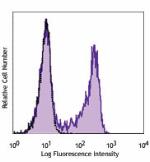
Human peripheral lymphocytes were stained with purified CCR6... -
Alexa Fluor® 647 anti-human CD196 (CCR6)
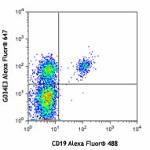
Human peripheral lymphocytes were stained with CD19 Alexa Fl... 
-
Brilliant Violet 421™ anti-human CD196 (CCR6)
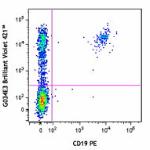
Human peripheral blood lymphocytes stained with CD19 PE and ... 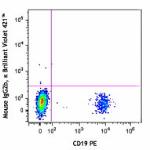
-
PerCP/Cyanine5.5 anti-human CD196 (CCR6)

Human peripheral lymphocytes were stained with CD19 APC and ... -
PE anti-human CD196 (CCR6)
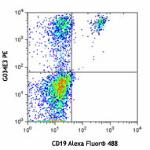
Human peripheral lymphocytes were stained with CD19 Alexa Fl... 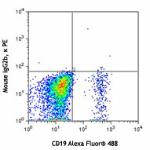
-
FITC anti-human CD196 (CCR6)
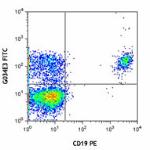
Human peripheral lymphocytes were stained with CD19 PE and C... 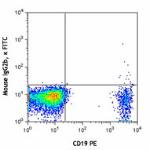
-
Alexa Fluor® 488 anti-human CD196 (CCR6)
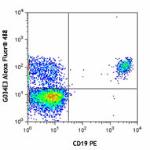
Human peripheral lymphocytes were stained with CD19 PE and C... 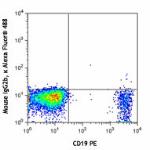
-
APC anti-human CD196 (CCR6)
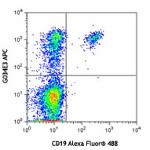
Human peripheral lymphocytes were stained with CD19 Alexa Fl... 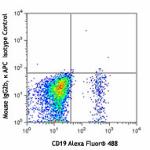
-
PE/Cyanine7 anti-human CD196 (CCR6)

Human peripheral lymphocytes were stained with CD19 Alexa Fl... -
Brilliant Violet 605™ anti-human CD196 (CCR6)

Human peripheral blood lymphocytes were stained with CD19 PE... -
Brilliant Violet 785™ anti-human CD196 (CCR6)
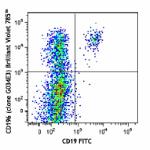
Human peripheral blood lymphocytes were stained with CD19 FI... -
Brilliant Violet 510™ anti-human CD196 (CCR6)
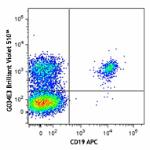
Human peripheral blood lymphocytes were stained with CD19 AP... 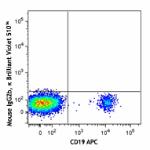
-
Brilliant Violet 650™ anti-human CD196 (CCR6)
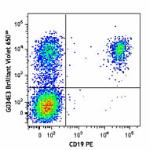
Human peripheral lymphocytes were stained with CD19 PE and C... 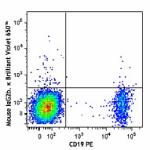
-
Purified anti-human CD196 (CCR6) (Maxpar® Ready)
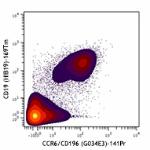
Human PBMCs stained with 169Tm-anti-CD19 (HIB19) and 141Pr-a... -
PE/Dazzle™ 594 anti-human CD196 (CCR6)

Human peripheral blood lymphocytes were stained with CD19 FI... 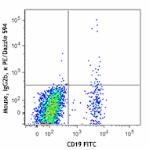
-
APC/Cyanine7 anti-human CD196 (CCR6)

Human peripheral blood lymphocytes were stained with CD19 FI... -
Alexa Fluor® 700 anti-human CD196 (CCR6)

Human peripheral blood lymphocytes were stained with CD19 FI... 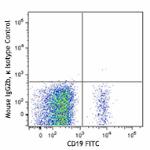
-
Brilliant Violet 711™ anti-human CD196 (CCR6)
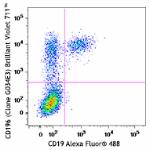
Human peripheral blood lymphocytes were stained with CD19 Al... 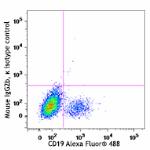
-
TotalSeq™-A0143 anti-human CD196 (CCR6)
-
Pacific Blue™ anti-human CD196 (CCR6)

Human peripheral lymphocytes were stained with CD19 FITC and... -
TotalSeq™-C0143 anti-human CD196 (CCR6)
-
APC/Fire™ 750 anti-human CD196 (CCR6)

Human peripheral blood lymphocytes were stained with CD19 FI... -
TotalSeq™-B0143 anti-human CD196 (CCR6)
-
TotalSeq™-D0143 anti-human CD196 (CCR6)
-
PE/Fire™ 640 anti-human CD196 (CCR6)

Human peripheral blood lymphocytes were stained with anti-hu... -
APC/Fire™ 810 anti-human CD196 (CCR6)

Human peripheral blood lymphocytes were stained with anti-hu... -
Spark NIR™ 685 anti-human CD196 (CCR6)

Human peripheral blood lymphocytes were stained with anti-hu... -
PE/Fire™ 700 anti-human CD196 (CCR6)

Human peripheral blood lymphocytes were stained with anti-hu... -
PE/Cyanine5 anti-human CD196 (CCR6)

Human peripheral blood lymphocytes were stained with anti-hu... -
Biotin anti-human CD196 (CCR6)

Human peripheral lymphocytes were stained with anti-human CD... -
PE/Fire™ 810 anti-human CD196 (CCR6)

Human peripheral blood lymphocytes were stained with anti-hu...
 Login / Register
Login / Register 


















Follow Us